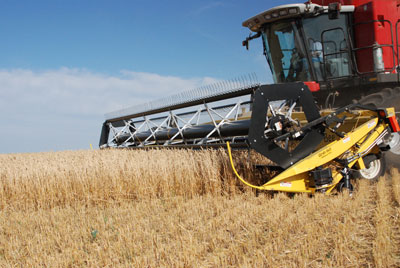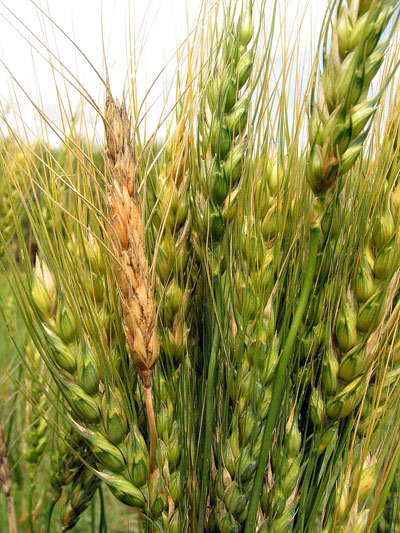
Features
Agronomy
Cereals
New DON toxin standards awaited
From field to plate, growers and processors all along the wheat products value chain are worried about the potential outcomes of Health Canada’s review of deoxynivalenol (DON) toxin standards. And it is no wonder.
September 19, 2011 By Heather Hager
From field to plate, growers and processors all along the wheat products value chain are worried about the potential outcomes of Health Canada’s review of deoxynivalenol (DON) toxin standards. And it is no wonder. The absence of Canadian DON standards for hard wheat and the tightening of standards in the European Union have resulted in some regulatory misunderstandings. Wheat dumping, refusal to purchase harvests, potential food recalls – even the national regulatory agency responsible for enforcing the existing standards has seemed to be confused about which standards to use.
 |
|
| The prospect of DON limits becoming so stringent that a large proportion of wheat will not meet milling quality is of particular concern to growers in the traditional Fusarium head blight areas. Photo by Bruce Barker.
|
“In some written and oral communication to millers and further processors, CFIA (Canadian Food Inspection Agency) has advised that Health Canada intends to adopt the European Union (EU) guidelines for DON and that the agency is therefore applying a maximum limit of 0.75 parts per million. In other written and oral communication, CFIA has advised that since there are no established guidelines for OTA [ochratoxin A] and DON, they are taking a zero tolerance approach…,” according to recorded testimony from Derek Jamieson, vice-president of P & H Milling Group, to the Standing Committee on Agriculture and Agri-Food in October 2009 (40th Parliament, 2nd Session), at a meeting convened specifically to address DON standards-related issues.
A complete transcript is available at www.parl.gc.ca/HousePublications/Publication.aspx?DocId=4157075&Language=E&Mode=1&Parl=40&Ses=2 .
Nothing has changed
In fact, Canadian DON standards have not yet changed. They remain under review by Health Canada, with a “revised health risk assessment anticipated to be completed by late this calendar year (2011) at the earliest,” according to Health Canada spokesperson Leslie Meerburg. DON standards are also under separate review by the Codex Alimentarius Commission, a joint Food and Agriculture Organization (FAO) and World Health Organization (WHO) body that develops international food safety guidelines.
 |
|
| To be prepared for future crop production, farmers and millers need to be informed about the status of standards reviews, their timelines and potential outcomes. Photo by Ralph Pearce.
|
However, there remains speculation, rumour and fear among Canadian growers that DON limits will become so stringent that a large proportion of their wheat will not meet milling quality. This is particularly a concern in traditional Fusarium head blight areas, where environmental conditions are often beneficial for the DON-producing Fusarium pathogen, and because crop resistance to the pathogen is not great.
It is also a concern for grain elevators and millers, as well as bakers, who particularly want to avoid food recalls, which can be damaging to their brand. “People are saying, ‘Well, I don’t know if I can buy this grain or not’,” says Richard Phillips, executive director of the Grain Growers Association of Canada. “So it causes confusion and uncertainty all the way back through the value chain.”
That can lead to lower prices at the farm gate, he says, because each entity in the chain is taking more risk and must increase the profit margin to account for it.
To be prepared for future crop production, the industry needs to be informed about the status of these standards reviews, their timelines and potential outcomes.
International standards review
The international review of DON standards under the Codex Alimentarius Commission has been ongoing for some time. According to the most recent report of the Codex Committee on Contaminants in Foods (CCCF), consideration of maximum levels for DON was discontinued in 2007 because of a lack of data. The work was restarted in 2010, with Canada chairing the working group on DON.
 |
|
| Health Canada is conducting its own DON health risk assessment for Canada, although for now, the agency cannot give any indication of how the standards might change. Photo courtesy of Dr. Andy Tekauz, AAFC.
|
The first draft recommendations were completed in January 2011, says Gordon Harrison, president of the Canadian National Millers Association. The 27-page document, titled Proposed Draft Maximum Levels for Deoxynivalenol (DON) and Its Acetylated Derivatives in Cereals and Cereal-based Products, summarizes much of what is currently known about DON, including toxicological effects, sampling methods, incidence and exposure data, milling and processing effects, and risk management considerations. The document proposes maximum limits for DON of 2 mg/kg (2 ppm) in “raw wheat, maize and barley, to be subjected to sorting or other physical treatment before human consumption or use as an ingredient in foodstuffs”; 1 mg/kg (1 ppm) in “all foods derived from wheat, barley and/or corn, including those intended for direct human consumption, except cereal-based foods for infants and young children”; and 0.5 mg/kg (0.5 ppm) in “cereal-based foods for infants (up to 12 months) and young children (12 to 36 months).”
As per procedure, the draft proposal was circulated to member countries and interested parties for comment and then discussed at a conference in the Netherlands in March 2011. The draft did not proceed to the finalization stage, but was returned to the working group for further development, including developing sampling plans, gathering additional data and reconsidering some of the proposed standards categories. It will be re-circulated and reconsidered at the Committee’s next session, according to the Report of the Fifth Session of the CCCF.
“As a member of the World Trade Organization, Canada is expected to review official Codex standards to determine whether they would also be appropriate for Canada based on a Canada-specific assessment,” says Meerburg. “They are reviewed in terms of achieving an appropriate level of health protection for people living in Canada.”
Any such Codex standards that are developed will be based on international data and a global-level assessment. Individual countries could still implement different standards. Meerburg says that Canada is not obligated to adopt the Codex standards or could adopt different standards, “provided that there is a defensible basis for doing so.” She adds, “Assessments on a national level will use scientific data that are more applicable to Canada and the Canadian population to address the specific national situation.”
Such data could include patterns of grain consumption and Fusarium occurrence and virulence in Canada.
National review
Meanwhile, Health Canada is conducting its own DON health risk assessment for Canada, after which it will develop risk management options. “A broad consultation will then ensue, during which time stakeholders will have the opportunity to comment on any proposed risk management options,” says Meerburg. “Health Canada will review the comments and modify the options, if warranted based on information submitted during the consultation, before adopting any revised risk management strategies.”
The current Canadian limits for DON that are under review are “2 ppm in uncleaned soft wheat intended for use in non-staple foods” and “1 ppm in uncleaned soft wheat for use in baby foods,” as listed on the Health Canada Bureau of Chemical Safety website. These do not differ greatly from the proposed maximum limits that were discussed by the Codex Committee.
One of the major issues growers and processors have with the current Canadian limits is that they are not comprehensive enough, only covering soft wheat, but not hard wheat, flour or other products. According to Jamieson’s statement to the Standing Committee on Agriculture and Agri-Food, “The flour milling industry is on record as asking Health Canada for hard wheat guidelines since 1994.”
Because no direction has ever been given, the millers, through the Canadian National Millers Association, set their own standard in 2003 of 1 ppm maximum on flour, says Sheilagh Arney, Canadian director of quality assurance, research and development, and regulatory and technical services for ADM Milling. “And those are the levels that we continue to meet until Health Canada and the Canadian Food Inspection Agency decide what levels they’re going to put in the regulations,” she adds.
But what those levels might be is anyone’s guess. Health Canada would give no indication of how the DON standards might change. “Health Canada’s review of the DON health risk assessment is not completed,” states Meerburg. “Therefore, we do not yet have a basis upon which to consider risk management.”
Factors to consider
The finalization of new DON standards for Canada would bring stability and reassurance to the country’s wheat value chain, but only if they are at a level that is achievable with the Canadian wheat crop. Arney says that millers must keep careful track of the DON levels in every lot of wheat they receive. Because Fusarium is so prevalent in eastern Canada, millers are often limited in the amount of eastern-grown wheat they can use at any given time, although it does differ by growing season.
Millers meet their self-imposed DON standard of 1 ppm on flour by blending different lots of wheat. “I don’t know what Health Canada is going to decide is acceptable,” notes Arney, “but we’re hoping that 1 ppm is the level that they’ll agree to because it has been doable even in poor crop years because it’s able to be blended. Any lower than that and I think people would be hard pressed in years when most of the crop is grade 2s.”
Phillips concludes, “The biggest thing that has to happen is that the government has to talk to industry sooner so that we can see what’s coming down the road and be prepared and either make a case as to why it shouldn’t happen, or figure out how we’re going to adapt to it, and/or figure out what is a proper time frame for this to work itself into our system.”
Such upfront and continuing communication would go a long way in minimizing confusion and disruption within the industry.
| Solutions for DON?
Growers will need to make optimal use of the tools they have for managing Fusarium in wheat to minimize deoxynivalenol (DON) levels. Traditional plant breeding for Fusarium-resistant varieties that also have good milling and other characteristics will remain a high priority. Growers will also need to stay on top of scouting and timely fungicide application. Another tool that may need to be reconsidered is genetically modified (GM) wheat. Wheat with GM resistance against Fusarium would be viable for the industry, only provided that it receives consumer acceptance, notes Richard Phillips, executive director of the Grain Growers Association of Canada. “I think a case has to be made that this will make your food safer,” he adds. “Modern biotechnology is not accepted for wheat at this stage,” notes Judy Shaw, who is head of corporate and government affairs for Syngenta. “There really has to be more of an acceptance demonstrated. There has to be the will and the pull-through by consumers demonstrated to bring that forward.” In fact, almost a decade ago, Syngenta developed a GM trait for wheat that gives it resistance to Fusarium. Field trials were performed in several areas from 2002 to 2004 through agreements with Agriculture and Agri-Food Canada (AAFC) and the Canadian Food Inspection Agency (CFIA). Shaw says that although the trait looked promising, consumers and the industry were not prepared to accept GM wheat at that time, so the research was put aside. “There is really no effective tool currently available to farmers that will ensure lower levels of DON,” says Shaw. “That’s where this trait has been particularly outstanding; the DON levels are greatly reduced in the research trials.” However, she notes that even if consumers and industry were to indicate that they would accept GM wheat, it would still take another 10 years or so to insert the trait into Canadian wheat varieties and complete the requisite testing and registration before those varieties would be available to growers. |